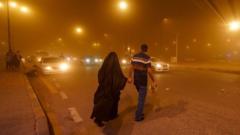Toxic air quality concerns rise as urban wildfires escalate due to climate change.
L.A. Wildfires Release Hazardous Chemicals into the Air

L.A. Wildfires Release Hazardous Chemicals into the Air
Study reveals alarming levels of lead and chlorine during Los Angeles wildfires
As the devastating wildfires sweep through Los Angeles County, studies reveal shocking spikes in airborne toxins, raising alarms about public health safety. According to recent measurements, levels of lead—a potent neurotoxin—soared to 100 times the average in parts of the city, even reaching areas located miles from the flames. Similarly, chlorine, known for its toxic properties, reached concentrations 40 times higher than normal.
Researchers utilized a cutting-edge network of sensors to capture and analyze air quality data in real time during the crisis. This alarming data, reported by The New York Times, highlights the unique risks associated with urban wildfires, which burn not only vegetation but also homes and infrastructures containing hazardous materials. Lead is commonly found in the paint and plumbing of older structures, while materials such as plastics emit chlorine and other harmful substances when ignited.
"This event serves as a crucial wake-up call," stated Haroula Baliaka, a Ph.D. candidate in atmospheric chemistry at the California Institute of Technology. She emphasized that today's wildfires are significantly more than just forest fires—they are complex urban fires fueled by the materials in our homes and cities. As climate change exacerbates fire risks in urbanized areas, the potential for toxic air pollution is expected to escalate.
The implications for Los Angeles are concerning. As breathing lead can lead to severe neurological issues, especially in children, and with chlorine posing risks to lung health, the long-term consequences may include an increase in health complications related to the wildfires. Historical data indicates that smoke from previous wildfires has already contributed to significant premature mortality and health crises in the region.
The findings from the wildfires are part of a broader, federally-funded initiative known as ASCENT, intended to monitor air pollution more comprehensively. Nga Lee Ng, an atmospheric scientist at the Georgia Institute of Technology and lead investigator for the network, underscored the need to analyze how urban fires differ in toxicity compared to natural wildfires.
As the frequency and intensity of wildfires grow in urban areas, scientists are increasingly focused on understanding the unique challenges posed by these fires and their broader implications for public health and environmental quality across affected regions.
Researchers utilized a cutting-edge network of sensors to capture and analyze air quality data in real time during the crisis. This alarming data, reported by The New York Times, highlights the unique risks associated with urban wildfires, which burn not only vegetation but also homes and infrastructures containing hazardous materials. Lead is commonly found in the paint and plumbing of older structures, while materials such as plastics emit chlorine and other harmful substances when ignited.
"This event serves as a crucial wake-up call," stated Haroula Baliaka, a Ph.D. candidate in atmospheric chemistry at the California Institute of Technology. She emphasized that today's wildfires are significantly more than just forest fires—they are complex urban fires fueled by the materials in our homes and cities. As climate change exacerbates fire risks in urbanized areas, the potential for toxic air pollution is expected to escalate.
The implications for Los Angeles are concerning. As breathing lead can lead to severe neurological issues, especially in children, and with chlorine posing risks to lung health, the long-term consequences may include an increase in health complications related to the wildfires. Historical data indicates that smoke from previous wildfires has already contributed to significant premature mortality and health crises in the region.
The findings from the wildfires are part of a broader, federally-funded initiative known as ASCENT, intended to monitor air pollution more comprehensively. Nga Lee Ng, an atmospheric scientist at the Georgia Institute of Technology and lead investigator for the network, underscored the need to analyze how urban fires differ in toxicity compared to natural wildfires.
As the frequency and intensity of wildfires grow in urban areas, scientists are increasingly focused on understanding the unique challenges posed by these fires and their broader implications for public health and environmental quality across affected regions.






















